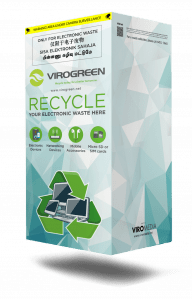As we have shared in our previous post, there is a NEED to mitigate the e-waste problem. In this post, I will share with you what has been done in Singapore to alleviate the e-waste situation, followed by what we can do.
What has been done?
In March 2019, it has been mandated by Singapore’s Ministry of the Environment and Water Resources (MEWR) for manufacturers of large household appliances — including refrigerators, air-conditioners, washing machines — to collect at least 60 per cent (in weight) of the appliances they supply to the market each year for recycling. Similarly, manufacturers for smaller consumer electronics such as lamps, portable batteries, and info-communication technology (ICT) equipment are required to collect at least 20% (Choo, 2019).
Virogreen e-waste collection bins
This has encouraged companies to form partnerships with recycling facilities to increase the ease of recycling by consumers. For example, telco M1 has partnered with recycling firm Virogreen to set up e-waste collection bins in malls.
Moving forward, Singapore will introduce regulatory measures to ensure that electrical and electronic waste (e-waste) is managed effectively and efficiently in Singapore. An e-waste management system will be established by 2021 (NEA, 2018). An overview of the system can be seen in the infographic below:
To find out the specific details and workings of the system, see here.
What can we, as consumers, do?
- Take good care of your electronics
With good care, you will be able to maintain the condition and lifespan of your electronics. This way, changes or replacement will be less frequent, and hence, less need for you to make new purchases, as well as dispose of unusable goods.
- Buy only what you need
The best way to resolve this e-waste problem is from our consumption. Reducing consumption is the most effective way to alleviate e-waste and its related environmental problem. Before making a purchase, ask yourself “Do I really need this?”. Buy only things that are necessary. This way, by reducing our consumption and carbon footprint, we can all play a part to nurse our Earth back to health.
- Donate your unwanted, but usable items
As the saying goes, “one man’s trash is another man’s treasure”. As such, instead of discarding what you deem as ‘outdated’ and ‘unwanted’, consider donating it. Perhaps it could be of use to others!
- Recycle, not dispose
I have said this before but recycling is the way to go. We surely do not want the leakage of harmful substances into our waterways or atmosphere. In Singapore, there are several e-waste recycling programmes such as StarHub’s RENEW (REcycling Nation’s Electronic Waste), ReCYCLE: Singtel x SingPost E-Waste Recycling Programme, IKEA’s Light Bulb Recycling Programme and more. Alternatively, you may drop off your e-waste at these designated recycling points.
Adapted from Geneco (2019) & Towards Zero Waste (2020).
References:
Choo, C. (2019 September 3). Trash Talk: A toxic trash pile grows when gadgets become waste — in a year or less. TODAYONLINE. https://www.todayonline.com/features/trash-talk-gadgets-designed-become-waste-year-or-less-toxic-trash-pile-grows
Geneco. (2019, September 25). Top Tips On Reducing The Electronic Waste Pollution In Singapore. https://blog.geneco.sg/knowledge/top-tips-on-reducing-the-electronic-waste-pollution-in-singapore
NEA. (2018 March 6). NEA To Implement E-waste Management System For Singapore By 2021. https://www.nea.gov.sg/media/news/news/index/nea-to-implement-e-waste-management-system-for-singapore-by-2021
Towards Zero Waste. (2020 September 15). Electronic Waste. https://www.towardszerowaste.gov.sg/ewaste/#:~:text=Singapore%20generates%20about%2060%2C000%20tonnes,technologies%20constantly%20replacing%20old%20ones.

